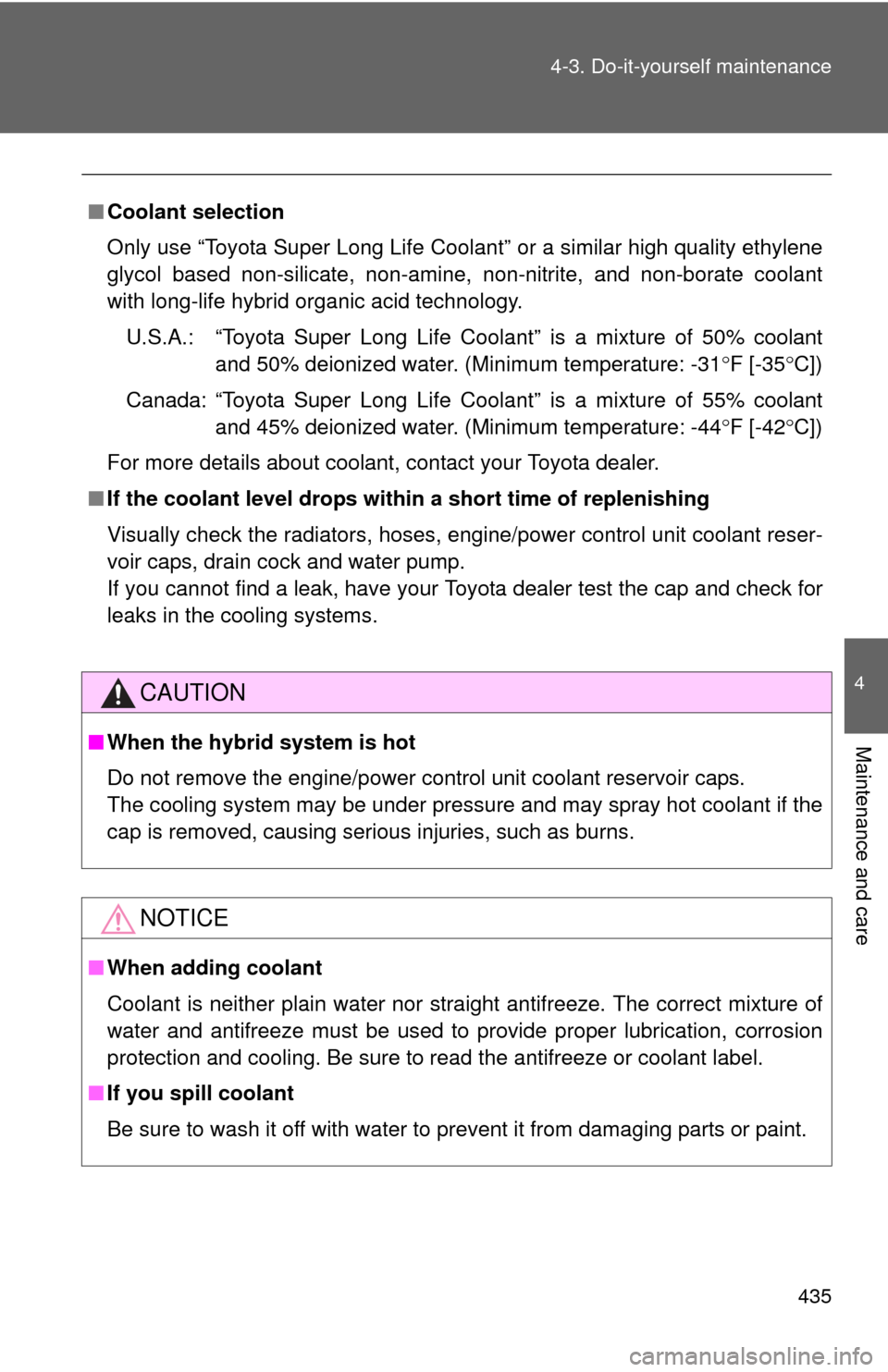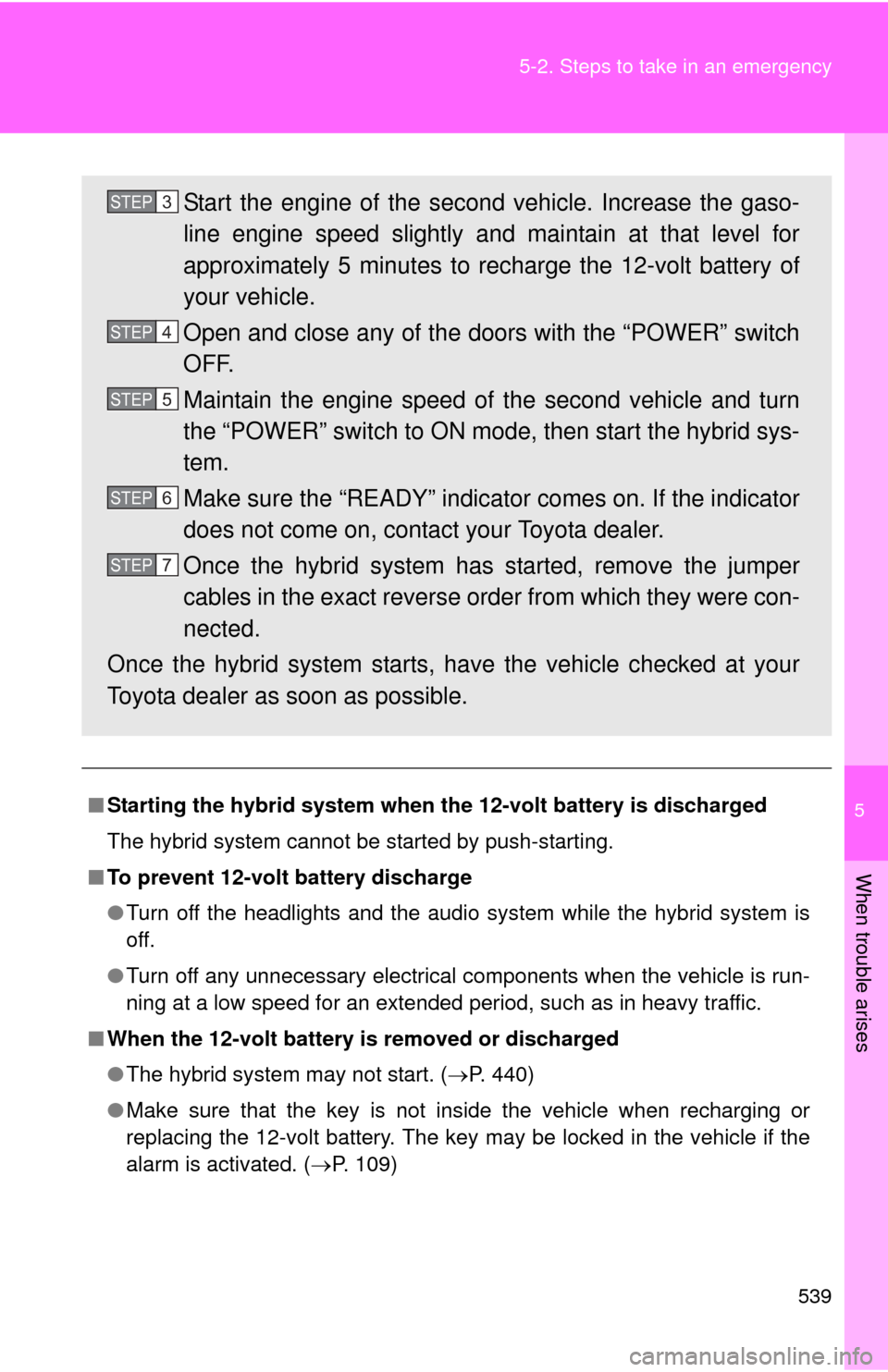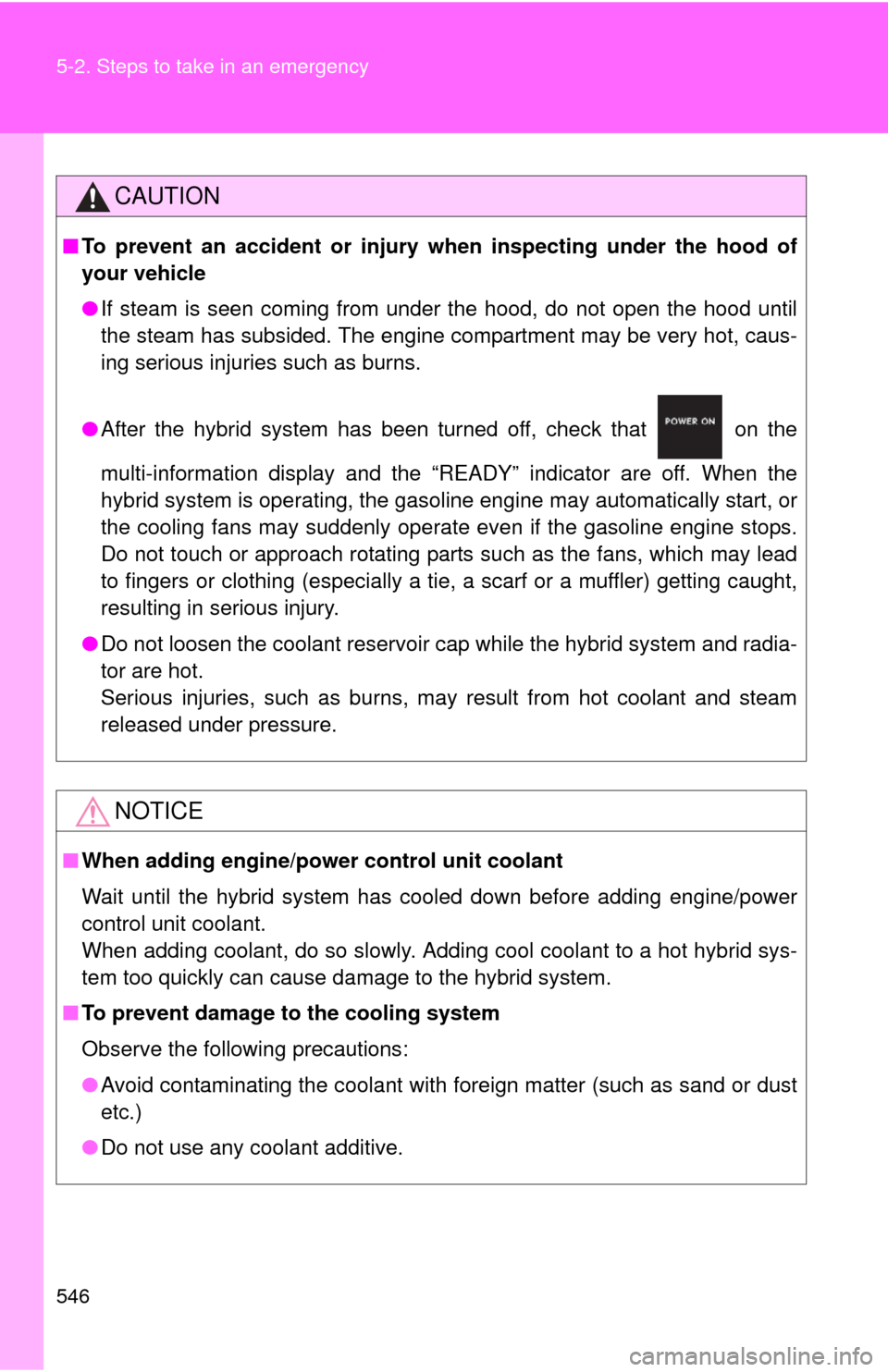Page 433 of 612
433
4-3. Do-it-yourself maintenance
4
Maintenance and care
NOTICE
■
To prevent serious engine damage
Check the oil level on a regular basis.
■ When replacing the engine oil
●Be careful not to spill engine oil on the vehicle components.
● Avoid overfilling, as the engine could be damaged.
● Check the oil level on the dipstick every time you refill the vehicle.
● Be sure the engine oil filler cap is properly tightened.
Page 435 of 612

435
4-3. Do-it-yourself maintenance
4
Maintenance and care
■
Coolant selection
Only use “Toyota Super Long Life Coolant” or a similar high quality ethylene
glycol based non-silicate, non-amine, non-nitrite, and non-borate coolant
with long-life hybrid organic acid technology.
U.S.A.: “Toyota Super Long Life Coolant” is a mixture of 50% coolant and 50% deionized water. (Minimum temperature: -31 F [-35 C])
Canada: “Toyota Super Long Life Coolant” is a mixture of 55% coolant and 45% deionized water. (Minimum temperature: -44 F [-42 C])
For more details about coolant, contact your Toyota dealer.
■ If the coolant level drops within a short time of replenishing
Visually check the radiators, hoses, engine/power control unit coolant reser-
voir caps, drain cock and water pump.
If you cannot find a leak, have your Toyota dealer test the cap and check for
leaks in the cooling systems.
CAUTION
■When the hybrid system is hot
Do not remove the engine/power control unit coolant reservoir caps.
The cooling system may be under pressure and may spray hot coolant if the
cap is removed, causing serious injuries, such as burns.
NOTICE
■When adding coolant
Coolant is neither plain water nor stra ight antifreeze. The correct mixture of
water and antifreeze must be used to provide proper lubrication, corrosion
protection and cooling. Be sure to read the antifreeze or coolant label.
■ If you spill coolant
Be sure to wash it off with water to prevent it from damaging parts or paint.
Page 460 of 612
460
4-3. Do-it-yourself maintenance
Checking and replacing fuses
If any of the electrical components do not operate, a fuse may have
blown. If this happens, check and replace the fuses as necessary.
Turn the “POWER” switch off.
Open the fuse box cover.
Engine compartment (type A fuse box) Push the tabs in and lift the lid
off.
Engine compartment (type B fuse box) Push the tabs in and lift the lid
off.
Under the instrument panel Remove the lid.STEP1
STEP2
Page 539 of 612

5
When trouble arises
539
5-2. Steps to take in an emergency
■
Starting the hybrid system when the 12-volt battery is discharged
The hybrid system cannot be started by push-starting.
■ To prevent 12-volt battery discharge
●Turn off the headlights and the audio system while the hybrid system is
off.
● Turn off any unnecessary electrical components when the vehicle is run-
ning at a low speed for an extended period, such as in heavy traffic.
■ When the 12-volt battery is removed or discharged
●The hybrid system may not start. ( P. 440)
● Make sure that the key is not inside the vehicle when recharging or
replacing the 12-volt battery. The key may be locked in the vehicle if the
alarm is activated. ( P. 109)
Start the engine of the seco nd vehicle. Increase the gaso-
line engine speed slightly and maintain at that level for
approximately 5 minutes to recharge the 12-volt battery of
your vehicle.
Open and close any of the doors with the “POWER” switch
OFF.
Maintain the engine speed of the second vehicle and turn
the “POWER” switch to ON mode, then start the hybrid sys-
tem.
Make sure the “READY” indicator comes on. If the indicator
does not come on, contact your Toyota dealer.
Once the hybrid system has started, remove the jumper
cables in the exact reverse or der from which they were con-
nected.
Once the hybrid system starts, have the vehicle checked at your
Toyota dealer as soon as possible.STEP3
STEP4
STEP5
STEP6
STEP7
Page 546 of 612

546 5-2. Steps to take in an emergency
CAUTION
■To prevent an accident or injury when inspecting under the hood of
your vehicle
● If steam is seen coming from under the hood, do not open the hood until
the steam has subsided. The engine compartment may be very hot, caus-
ing serious injuries such as burns.
● After the hybrid system has been turned off, check that on the
multi-information display and the “READY” indicator are off. When the
hybrid system is operating, the gasoline engine may automatically start, or
the cooling fans may suddenly operate even if the gasoline engine stops.
Do not touch or approach rotating parts such as the fans, which may lead
to fingers or clothing (especially a tie, a scarf or a muffler) getting caught,
resulting in serious injury.
● Do not loosen the coolant reservoir cap while the hybrid system and radia-
tor are hot.
Serious injuries, such as burns, may result from hot coolant and steam
released under pressure.
NOTICE
■When adding engine/power control unit coolant
Wait until the hybrid system has cooled down before adding engine/power
control unit coolant.
When adding coolant, do so slowly. Adding cool coolant to a hot hybrid sys-
tem too quickly can cause damage to the hybrid system.
■ To prevent damage to the cooling system
Observe the following precautions:
●Avoid contaminating the coolant with foreign matter (such as sand or dust
etc.)
● Do not use any coolant additive.
Page 553 of 612
553
6-1. Specifications
6
Vehicle specifications
Lubrication system
*: The engine oil capacity is a reference quantity to be used when changing the
engine oil. Warm up the engine and turn off the hybrid system, wait more
than 5 minutes, and check the oil level on the dipstick.
■Engine oil selection
“Toyota Genuine Motor Oil” is used in your Toyota vehicle. Use
Toyota approved “Toyota Genuine Motor Oil” or equivalent to satisfy
the following grade and viscosity.
Oil grade: ILSAC GF-5 multigrade engine oil
Recommended viscosity: SAE 0W-20
SAE 0W-20 is the best choice for
good fuel economy and good
starting in cold weather.
If SAE 0W-20 is not available,
SAE 5W-20 oil may be used.
However, it must be replaced
with SAE 0W-20 at the next oil
change.
Oil capacity
(Drain and refill
refer-
ence*) With filter
Without filter 4.6 qt. (4.4 L, 3.9 Imp. qt.)
4.2 qt. (4.0 L, 3.5 Imp. qt.)
Outside temperature
Page 556 of 612
556 6-1. Specifications
Electrical system
Transmission
*: The fluid capacity is a reference quantity. If replacement is necessary, con-tact your Toyota dealer.
Battery
Open voltage* at
68 F (20 C): 12.6 12.8 V Fully charged
12.2 12.4 V Half charged
11 . 8
12.0 V Discharged
(*: Voltage checked 20 minutes after the
engine and all the lights are turned off)
Charging rates 5 A max.
Fluid capacity* 3.9 qt. (3.7 L, 3.3 Imp. qt.)
Fluid typeToyota Genuine ATF WS
NOTICE
■Transmission fluid type
Using transmission fluid other than “Toyota Genuine ATF WS” may ulti-
mately damage the transmission of your vehicle.
Page 602 of 612

602 Alphabetical index
EngineAccessory mode.................... 157
Compartment ........................ 429
Hood...................................... 426
How to start the
hybrid system...................... 157
Identification number ............. 550
If the hybrid system will not start ............................... 531
Ignition switch........................ 157
Overheating........................... 542
“POWER” switch ................... 157
Engine coolant Capacity ................................ 555
Checking ............................... 434
Preparing and checking before winter ....................... 229
Engine coolan t temperature
display .................................... 174
Engine oil
Capacity ................................ 553
Checking ............................... 430
Preparing and checking before winter ....................... 229
Engine/power control unit coolant
Capacity ................................ 555
Checking ............................... 434
Preparing and checking before winter ....................... 229
EPS ............................................ 207
EV drive mode .......................... 165
Event data recorder ...................23 Floor mat .................................. 388
Fluid
Brake..................................... 436
Washer.................................. 438
Fog lights
Replacing light bulbs ............. 471
Switch ................................... 198
Wattage................................. 560
Front fog lights Switch ................................... 198
Wattage................................. 560
Front passenger occupant classification system ............ 125
Front passenger's seat belt
reminder light ........................ 493
Front seats Adjustment .............................. 76
Front side marker lights Replacing light bulbs ............. 471
Wattage................................. 560
Front turn signal lights Replacing light bulbs ............. 471
Wattage................................. 560
Fuel Capacity ................................ 552
Fuel gauge ............................ 174
Gas station information ......... 612
Information ............................ 561
Refueling ............................... 102
Type ...................................... 552
Fuel door .................................. 102
Fuel filler door .......................... 102
Fuses ........................................ 460F